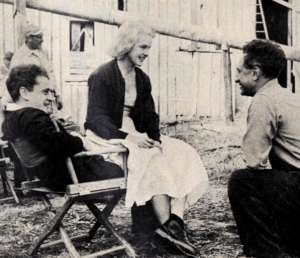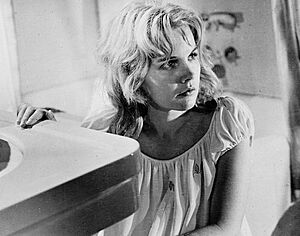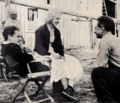Jack Garfein facts for kids
Quick facts for kids
Jack Garfein
|
|
|---|---|
 |
|
| Born |
Jakob Garfein
July 2, 1930 Mukacevo, Carpathian Ruthenia, Czechoslovakia (now Mukacheve, Ukraine)
|
| Died | December 30, 2019 (aged 89) United States
|
| Education | Dramatic Workshop at New School of Social Research, American Theater Wing |
| Occupation | Director, Writer, Producer, Teacher |
| Spouse(s) | Carroll Baker (m. 1955–69) Anna Loretta (m. 2003-07) Natalia Repolovsky (m. 2019) |
| Children | Blanche Baker Herschel Garfein Rela Garfein Elias Garfein |
Jakob Garfein (July 2, 1930 – December 30, 2019) was an American film and theater director, writer, and teacher. He was a very important person at the Actors Studio, a famous place for actors to learn.
Jack Garfein grew up in Bardejov, Czechoslovakia. When he was 13, he was sent to Auschwitz during the rise of Nazism. He survived 11 different concentration camps. In 1946, as a teenager who had lost his family, he came to the U.S. as one of the first Holocaust survivors. He became an American citizen in 1952.
After studying in New York, Garfein became the first theater director to join the Actors Studio. He directed their first play to move to Broadway, End as a Man (1953). He also helped bring a special acting style called Method Acting to Hollywood. He did this by starting Actors Studio West with actor Paul Newman in 1966. He taught many famous actors like Sissy Spacek and Ron Perlman. He also directed stars like Shelley Winters and Jessica Tandy. He even helped discover actors like Steve McQueen and Ben Gazzara. He gave James Dean his first acting role.
In Hollywood, Garfein worked with famous directors like Elia Kazan. He made two movies that were very brave for their time. They talked about tough topics and faced some problems because of it. For example, in The Strange One (1957), he showed the issue of racism in America. As a Holocaust survivor, he was shocked by segregation in the U.S. He fought hard to have African-American actors in his film.
Contents
Jack Garfein's Early Life
Jack Garfein was born into a Jewish family in Mukachevo. He grew up in a small town called Bardejov, which was in Czechoslovakia (now Slovakia). His father worked at the family's sawmill. During the rise of Nazism, his father tried to fight back. But in 1942, he was caught and sent to Auschwitz. In 1943, Jack, his mother, and younger sister hid in Hungary. But in 1944, they were also sent to Auschwitz. Sadly, his whole family died during the Holocaust. Jack survived 11 different concentration camps.
At the end of the war, the British Army freed him from the Bergen-Belsen camp. He was very weak, weighing only 48 pounds. He was sent to an orphanage in Sweden. There, a kind nun named Hedvig Ekberg helped him get better. He called her his "second mother." Years later, he visited her when promoting his film Something Wild (1961).
In 1946, an American official visited the orphanage. He offered Jack the chance to move to the U.S. Jack joined his uncle in New York. A group called the Jewish Child Care Association helped him. In 1947, they helped him get a scholarship to study at the Dramatic Workshop at The New School for Social Research.
Garfein learned acting from a famous German director, Erwin Piscator. His classmates included future stars like Walter Matthau and Tony Curtis. During this time, he started his own theater group called The New Horizon Players. Here, he learned how to direct and act. In 1948, Piscator chose him for the main role in a play called "The Burning Bush." Later, he directed plays like Home of the Brave (1950).
With encouragement from his teachers, Garfein went on to study directing at the American Theatre Wing. After he graduated at age 20, NBC hired him. He directed short plays for a TV show called The Kate Smith Hour.
Jack Garfein's First Works
A famous teacher named Lee Strasberg was impressed by Garfein's play Camille. Strasberg invited him to the Actors Studio. There, Garfein directed and produced the Studio's first full-length play, End as a Man (1953). Before this, the Studio mostly focused on short acting exercises.
Both Strasberg and director Elia Kazan loved End as a Man. It opened in a small theater and was a huge success. The play then moved to Broadway, which was a very big deal. It helped make Ben Gazzara a rising star. At just 23 years old, Garfein won an award for being the best director on Broadway.
In 1955, Garfein was invited to become a member of the Actors Studio. This is where he met Carroll Baker, who was also a student. They later got married.
Jack and Carroll had two children. Their daughter, Blanche Baker, became an Emmy Award-winning actress. Their son, Herschel Garfein, became a Grammy Award-winning composer.
Career as a Theater Director
After End as a Man, Garfein directed three more plays on Broadway. These included Girls of Summer (1956), starring Shelley Winters. He also directed many plays in smaller theaters (off-Broadway). These included plays by famous writers like Eugene O'Neill and Arthur Miller.
Garfein started two theaters in New York City: the Samuel Beckett Theater (1974) and the Harold Clurman Theatre (1978). He was good friends with the famous writer Samuel Beckett. Beckett even gave Garfein the rights to put on his play Night and Dreams (1982) for the first time on stage.
In 2013, Garfein directed a play based on Franz Kafka's "A Report to the Academy" in Paris, France.
Career as a Film Director
Garfein's first movie was The Strange One (1957). It was based on his play End as a Man. The film was about a military school in the South. It showed how a cruel student could control others. This movie reminded some people of the Nazi fascism Garfein had seen. The Strange One caused arguments about race in Hollywood. The studio did not want to include scenes with Black actors. They worried it would hurt the film's success in the South, where segregation was common. But Garfein refused to give in and filmed the scenes anyway.
His second movie was Something Wild (1961). It was an independent film, meaning Garfein made it himself. In this movie, his wife, Carroll Baker, played a young woman held captive. This film also caused some debate. Garfein said that Something Wild was not shown in many major U.S. cities. He also said he wasn't offered another film job after it came out.
However, Something Wild was much more popular in Europe. Famous French director François Truffaut and Italian critic Alberto Moravia liked it. Some even compared Garfein's directing style to the famous Swedish director Ingmar Bergman. Critics said the film showed deep feelings like guilt, shame, and trauma.
Teaching Career
Jack Garfein was one of the few people who were not actors to become a member of The Actors Studio. In 1966, he became the director of the Studio's Los Angeles branch, which he helped start with Paul Newman. In 1974, he opened the Actors and Directors Lab in New York. Many well-known people studied there, including Sissy Spacek. For over 40 years, Garfein taught acting and directing classes in places like London, Budapest, and Paris.
Based on his many years of teaching, Garfein wrote a book called Life and Acting - Techniques for the Actor (2010). In 2012, he won an award in France called the Masque d'Or for being the best acting teacher.
Jack Garfein's Legacy
In 1984, a famous French film museum, The Cinémathèque Française, honored Garfein's work. They showed his two films, The Strange One and Something Wild. These showings were also held in Spain later that year.
In 2010, the UCLA Film and Television Archive honored Garfein in Los Angeles. They showed his two films and a documentary called A Journey Back (1987). This film showed Garfein visiting Auschwitz and his childhood home.
Similar events were held in New York City in 2011 and in London in 2014. Other showings of Garfein's films have taken place in Paris, Lyon, and in Israel.
Images for kids



